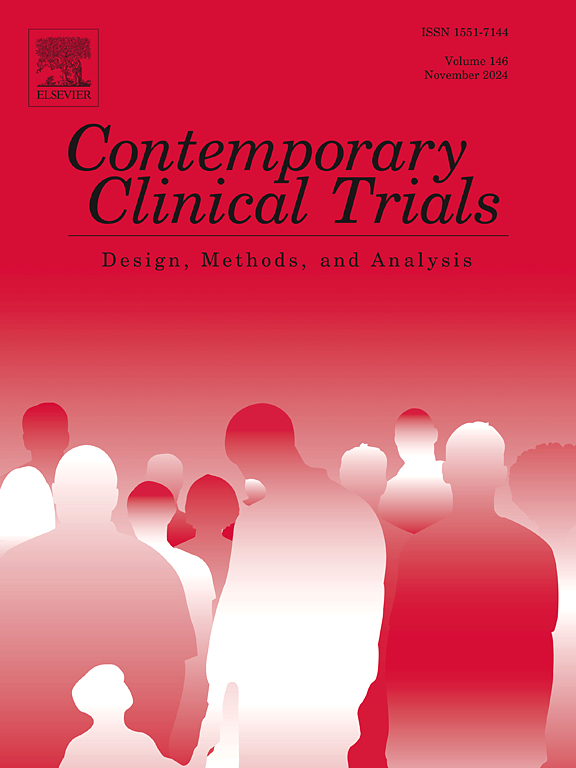A phase 3 adaptive dose selection trial of NCX 470, a nitric oxide-donating bimatoprost for open-angle glaucoma or ocular hypertension: The MONT BLANC study
IF 2
3区 医学
Q3 MEDICINE, RESEARCH & EXPERIMENTAL
引用次数: 0
Abstract
Purpose
To identify the optimal dose of NCX 470, a nitric oxide (NO)-donating bimatoprost, for comparison to latanoprost in a phase 3 trial for open-angle glaucoma (OAG) or ocular hypertension (OHTN) using an adaptive dose selection design.
Patients and methods
In this prospective, multicenter trial, subjects were randomized 1:1:1 to NCX 470 0.065 %, NCX 470 0.1 %, or latanoprost 0.005 % dosed topically to both eyes once daily. After at least 30 subjects were assigned to each group, interim analysis was undertaken at 2 weeks and an independent committee selected the final NCX 470 dose for the full 12-week trial.
Results
The interim analysis included 103 subjects. The least-squares mean (95 % confidence interval [CI]) difference in diurnal intraocular pressure (IOP) was −1.51 mmHg (−2.88, −0.14) in the NCX 470 0.065 % group (p = 0.0308) and − 1.71 mmHg (−3.04, −0.38) in the NCX 470 0.1 % group (p = 0.0123), both favoring NCX 470 over latanoprost. The most common side effect was conjunctival/ocular hyperemia, the frequency and severity of which were similar in both NCX 470 dosing groups (p > 0.05). NCX 470 0.1 % was selected as the final dose and the NCX 470 0.065 % dose arm was terminated with subsequent subjects randomized 1:1 to NCX 470 0.1 % or latanoprost.
Conclusion
Both concentrations of the NO-donating bimatoprost NCX 470 lower IOP more than latanoprost following 2 weeks of daily therapy. This adaptive dose selection design allowed identification of the optimal dose of NCX 470 with reduced trial costs, recruitment time, and the number of patients exposed to study medication.
治疗开角型青光眼或眼压过高的一氧化氮供体比马前列素 NCX 470 的 3 期适应性剂量选择试验:MONT BLANC研究。
目的:在一项治疗开角型青光眼(OAG)或眼压过高(OHTN)的3期试验中,采用自适应剂量选择设计,确定一氧化氮(NO)捐献型比马前列素NCX 470的最佳剂量,并与拉坦前列素进行比较:在这项前瞻性多中心试验中,受试者按1:1:1的比例随机分配到NCX 470 0.065 %、NCX 470 0.1 %或拉坦前列素0.005 %,每天一次,双眼局部用药。在每组至少分配了30名受试者后,在2周时进行了中期分析,并由一个独立委员会选定了整个12周试验的最终NCX 470剂量:结果:中期分析包括103名受试者。NCX 470 0.065%组的昼间眼压(IOP)最小二乘平均值(95%置信区间[CI])为-1.51 mmHg (-2.88, -0.14)(p = 0.0308),NCX 470 0.1%组为-1.71 mmHg (-3.04, -0.38)(p = 0.0123),NCX 470均优于拉坦前列素。最常见的副作用是结膜/眼球充血,两个NCX 470剂量组出现这种副作用的频率和严重程度相似(p > 0.05)。NCX 470 0.1%被选为最终剂量,NCX 470 0.065%剂量组被终止,随后受试者按1:1随机分配到NCX 470 0.1%或拉坦前列素:结论:两种浓度的NO-供体比马前列素NCX在每日治疗2周后降低眼压的效果均优于拉坦前列素。这种自适应剂量选择设计可以确定NCX 470的最佳剂量,同时减少试验成本、招募时间和接触研究药物的患者人数。
本文章由计算机程序翻译,如有差异,请以英文原文为准。
求助全文
约1分钟内获得全文
求助全文
来源期刊
CiteScore
3.70
自引率
4.50%
发文量
281
审稿时长
44 days
期刊介绍:
Contemporary Clinical Trials is an international peer reviewed journal that publishes manuscripts pertaining to all aspects of clinical trials, including, but not limited to, design, conduct, analysis, regulation and ethics. Manuscripts submitted should appeal to a readership drawn from disciplines including medicine, biostatistics, epidemiology, computer science, management science, behavioural science, pharmaceutical science, and bioethics. Full-length papers and short communications not exceeding 1,500 words, as well as systemic reviews of clinical trials and methodologies will be published. Perspectives/commentaries on current issues and the impact of clinical trials on the practice of medicine and health policy are also welcome.

 求助内容:
求助内容: 应助结果提醒方式:
应助结果提醒方式:


